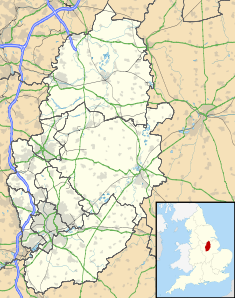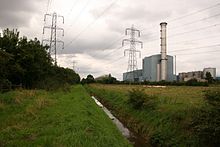- Cottam power stations
-
Cottam power station 
Cottam Power Station
Viewed from the north in July 2006Location of Cottam power station Country England Location Cottam Coordinates 53°18′14″N 0°46′53″W / 53.304°N 0.7815°WCoordinates: 53°18′14″N 0°46′53″W / 53.304°N 0.7815°W Status Operational Commission date 1969 Operator(s) Central Electricity Generating Board
(1969-1990)
Powergen
(1990-2000)
London Energy
(2000-present)Power station information Primary fuel Coal Secondary fuel Gas Tertiary fuel Biomass Power generation information Installed capacity 1,970 MW grid reference NZ174644 The Cottam power stations are a pair of power stations, located on the River Trent at Cottam near Retford in Nottinghamshire. The largest of the two is a coal-fired power station, which was commissioned in 1969 by the Central Electricity Generating Board, and has a generating capacity of 1,970 megawatts (MW). It is now owned by EDF Energy.[1] The other is Cottam Development Centre, a combined cycle gas turbine plant commissioned in 1999, with a generating capacity of 400 MW. This plant is owned by E.ON UK.
The site is one of a number of power stations located long the Trent valley, with the West Burton power stations located 3.5 miles (5.6 km) downstream of the station, and Ratcliffe-on-Soar power station located 52 miles (84 km) upstream. The decommissioned High Marnham Power Station is located 6 miles (9.7 km) upstream.
Contents
History
It opened in 1969 when owned by the Central Electricity Generating Board. After electricity privatisation in 1990, ownership was shifted to Powergen. In October 2000, the plant was sold to London Energy, who are part of EDF Energy, for £398 million.[2]
Cottam Development Centre
The Cottam Development Centre is a 400 MW combined cycle gas turbine (CCGT) power station, fuelled by natural gas. It was built as a joint venture between Powergen and Siemens, as a testbed for Siemens to develop CCGT technology.
Construction of the station commenced in July 1997 on a football and cricket pitch adjacent to the coal-fired power station. During construction, heavy components weighing up to 400 tonnes were brought onto site using inland waterways, to avoid damaging local roads.[3] The station opened in September 1999. In May 2002 the station was bought out by Powergen for £52 million.
Specification
The power station generates electricity using a single Siemens V94.3A (now called a SGT5-4000F), which has one BENSON heat recovery steam generator gas turbine and one steam turbine.[4][5] Electricity from the station has a terminal voltage of 21 kilovolts (kV), and enters the National Grid via a transformer at 400 kV. The plant has a thermal efficiency of 58%.[3]
Industrial action
Wildcat strike - 2004
Wildcat strike action was taken in December 2004, when scaffolding collapsed and injured one worker.[6]
Wildcat strike - 2006
In February 2006, 51 British workers at the station walked out on Wildcat strike action due to the underpayment of Hungarian workers during construction of Flue Gas Desulphurisation equipment. The Hungarians had worse working conditions than the British workers and were underpaid £1 million by employer SFL. 15 British workers who walked out in solidarity were made redundant.[6]
References
- ^ "Power Station Locations and Capacities". United Kingdom Quality Ash Association. http://www.ukqaa.org.uk/PowerStation.html. Retrieved 6 February 2011.
- ^ "Powergen generates £398m from Cottam". The Telegraph (London). 2000-10-17. http://www.telegraph.co.uk/money/main.jhtml?xml=/money/2000/10/17/cnpow17.xml. Retrieved 2008-08-02.
- ^ a b "Cottam Development Centre" (ASP). E.On UK. http://www.eon-uk.com/generation/cottam.aspx. Retrieved 6 February 2011.
- ^ "SGT5-4000F". Siemens. http://www.powergeneration.siemens.com/products-solutions-services/products-packages/gas-turbines/large-scale-50hz/sgt5-4000f. Retrieved 2008-08-02.
- ^ "BENSON HRSG". Siemens. http://www.powergeneration.siemens.com/products-solutions-services/power-plant-soln/steam-turbine-power-plants/benson-boiler/benson-hrsg/. Retrieved 2008-08-02.
- ^ a b Steven (1 March 2006). "UK: Cottam power station wildcat strike". http://libcom.org/news/article.php/cottam-power-station-strike-010306. Retrieved 2 November 2009.
External links
Power stations of the Trent Valley Upstream:
High Marnham Power StationCottam power stations Downstream:
West Burton Power StationElectricity generation in the East Midlands Power stations ActiveActiveClosedCastle Donnington · Derby · Drakelow · Freeman's Meadow · High Marnham · Nottingham · Northampton · Spondon · Staythorpe · Wilford · WillingtonActiveProposed/FutureHydroActiveTorrsIncinerators/WasteActiveNottinghamActiveProposed/FutureLincs · Race Bank · Triton Knoll
Organisations Categories:- Buildings and structures in Nottinghamshire
- Coal-fired power stations in England
- Natural gas-fired power stations in England
- Power stations in the East Midlands
- 1969 establishments in England
- Biofuel power stations in England
Wikimedia Foundation. 2010.


